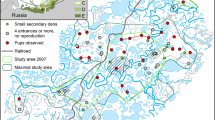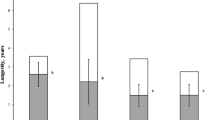Summary
We studied the reproductive investment of microtine rodents (bank vole (Clethrionomys glareolus),Microtus epiroticus andMicrotus agrestis) in western Finland under predation risk from small mustelids. During 1984–1992, the yearly mean litter size of overwintered bank voles was smaller at high least weasel and stoat densities than at low densities (close to 3 versus 4–5). In addition, the annual mean litter size of young bank voles was negatively correlated to the least weasel density. In youngM. agrestis voles, the yearly late summer litter size was negatively associated with the autumn density of small mustelids. In the crash phase of the vole cycle (1989 and 1992), we removed small mustelids (mainly least weasels) from four unfenced areas in late April to late May and studied the reproduction of voles in four removal and comparable control areas (each 2–4 km2). Reduction of small mustelids significantly increased the proportion of pregnant bank vole females, but not that of pregnantMicrotus vole females. We conclude that predation risk apparently reduced reproductive investment of free-living bank vole females; these voles appear to trade their current parental investment against future survival and reproductive prospects. Accordingly, the presence of small mustelids (or their scent) may slow down the reproductive rate of voles. As antipredatory behaviours occurred on a large scale, our results add evidence to the hypothesis that crashes in multiannual vole cycles are driven by small mustelid predators.
Similar content being viewed by others
References
Boonstra, R. and Boag, P.T. (1987) A test of the Chitty Hypothesis: inheritance and life history traits in meadow volesMicrotus pennsylvanicus.Evolution 41, 929–47.
Bujalska, G. (1973) The role of spacing behaviour among females in the regulation of reproduction in the bank vole.J. Reproduct. Fert. Suppl. 19, 463–72.
Clutton-Brock, T.H. (1984) Reproductive effort and terminal investment in iteroparous animals.Am. Nat. 123, 212–29.
Cushing, B.S. (1986) Estrous mice and vulnerability to weasel predation.Ecology 66, 1976–8.
Daly, M., Wilson, M., Behrends, P.R. and Jacobs, L.F. (1990) Characteristics of kangaroo rats,Dipodomys merriami, associated with differential predation risk.Anim. Behav. 40, 380–9.
Erlinge, S. (1974) Distribution, territoriality and numbers of the weasel (Mustela nivalis) in relation to prey abundance.Oikos 25, 308–14.
Erlinge, S. (1977) Spacing strategy in stoatMustela erminea.Oikos 28, 32–42.
Erlinge, S. (1983) Demography and dynamics of a stoatMustela erminea population in a diverse community of vertebrates.J. Anim. Ecol. 52, 705–26.
Erlinge, S., Johansson, B. and Willstedt, H. (1974) Jaktbeteende och bytesval hos småvesslan. Fauna o.Flora 69, 95–101.
Hakkarainen, H., Korpimäki, E., Mappes, T. and Palokangas, P. (1992) Kestrel hunting behaviour towards solitary and groupedMicrotus agrestis andM. epiroticus — a laboratory experiment.Ann. Zool. Fennici 29, 279–84.
Hanski, I., Turchin, P., Korpimäki, E. and Henttonen, H. (1993) Population oscillations of boreal rodents: regulation by mustelid predators leads to chaos.Nature 364, 232–5.
Hansson, L. (1969) Spring populations of small mammals in central Swedish Lapland in 1964–68.Oikos 20, 431–50.
Hansson, L. (1982) Experiments on habitat selection in voles: implications for the inverse distribution of two common European species.Oecologia 52, 246–52.
Hansson, L. (1984) Winter reproduction of small mammals in relation to food conditions and population dynamics.Bull. Carnegie Museum Natural History 10, 225–34.
Hansson, L. (1987) An interpretation of rodent dynamics as due to trophic interactions.Oikos 50, 308–18.
Hansson, L. and Henttonen, H. (1988) Rodent dynamics as community processes.Trends Ecol. Evol. 3, 195–200.
Hansson, L. and Hoffmeyer, I. (1973) Snap and live trap efficiency for south Scandinavian small mammals.Oikos 24, 477–8.
Henttonen, H., Oksanen, T., Jortikka, A. and Haukisalmi, V. (1987) How much do weasels shape microtine cycles in the northern Fennoscandian taiga?Oikos 50, 353–65.
Hoffman, R.S. (1958) The role of reproduction and mortality in population fluctuations of voles (Microtus).Ecol. Monogr. 28, 79–109.
Hurlbert, S.H. (1984) Pseudoreplication and the design of ecological field experiments.Ecol. Monogr. 54, 187–211.
Ives, A.R. and Dobson, A.P. (1987) Antipredator behavior and the population dynamics of simple predator—prey systems.Am. Nat. 130, 431–47.
Jedrzejewska, B. and Jedrzejewski, W. (1990a) Antipredatory behaviour of bank voles and prey choice of weasels — enclosure experiments.Ann. Zool. Fennici 27, 321–8.
Jedrzejewski, W. and Jedrzejewska, B. (1990b) Effect of a predator's visit on the spatial distribution of bank voles: experiments with weasels.Can. J. Zool. 68, 660–6.
Jedrzejewski, W., Jedrzejewska, B. and McNeish, E. (1992) Hunting success of the weaselMustela nivalis and escape tactics of forest rodents in Bialowieza National Park.Acta Theriol. 37, 319–28.
Jedrzejewski, W., Rychlik, L. and Jedrzejewska, B. (1993) Responses of bank voles to odours of seven species of predators — experimental data and their relevance to natural predator—vole relationships.Oikos,68, 251–7.
Karlsson, A.F. (1988) Over-winter survival in a boreal population of the bank vole,Clethrionomys glareolus.Can. J. Zool. 66, 1835–40.
King, C.M. (1989)The Natural History of Weasels and Stoats. Christopher Helm, London.
Korpimäki, E. (1984) Population dynamics of birds of prey in relation to fluctuations in small mammal populations in western Finland.Ann. Zool. Fennici 21, 287–93.
Korpimäki, E. (1985) Rapid tracking of microtine populations by their avian predators: possible evidence for stabilizing predation.Oikos 45, 281–4.
Korpimäki, E. (1986) Predation causing synchronous decline phases in microtine and shrew populations in western Finland.Oikos 46, 124–7.
Korpimäki, E. (1993) Regulation of multiannual vole cycles by density-dependent avian and mammalian predation.Oikos 66, 359–63.
Korpimäki, E. and Norrdahl, K. (1987) Low proportion of shrews in the diet of small mustelids in western Finland.Z. Säugetierkd. 52, 257–60.
Korpimäki, E. and Norrdahl, K. (1989a) Avian predation on mustelids in Europe 2: impact on small mustelid and microtine dynamics — a hypothesis.Oikos 55, 273–6.
Korpimäki, E. and Norrdahl, K. (1989b) Predation of Tengmalm's owls: numerical responses, functional responses and dampening impact on population fluctuations of voles.Oikos 54, 154–64.
Korpimäki, E. and Norrdahl, K. (1991a) Do breeding nomadic avian predators dampen population fluctuations of small mammals?Oikos 62, 195–208.
Korpimäki, E. and Norrdahl, K. (1991b) Numerical and functional responses of Kestrels, Short-eared Owls, and Long-eared Owls to vole densities.Ecology 72, 814–26.
Korpimäki, E., Norrdahl, K. and Rinta-Jaskari, T. (1991) Responses of stoats and least weasels to fluctuating vole abundances: is the low phase of the vole cycle due to mustelid predation?Oecologia 88, 552–61.
Krebs, C.J. and Myers, J.H. (1974) Population cycles in small mammals.Adv. Ecol. Res. 8, 267–399.
Krebs, C.J., Gaines, M.S., Keller, B.L., Myers, J.H. and Tamarin, R.H. (1973) Population cycles in small rodents.Science 179, 35–41.
Lidicker, W.Z.J. (1988) Solving the enigma of microtine “cycles”.J. Mammal. 69, 225–35.
Lima, S.L. and Dill, L.M. (1990) Behavioural decisions made under the risk of predation: a review and prospectus.Can. J. Zool. 68, 619–40.
Magnhagen, C. (1990) Reproduction under predation risk in the sand goby,Pomatoschistus minutus, and the black goby,Gobius niger: the effect of age and longevity.Behav. Ecol. Sociobiol. 26, 331–5.
Magnhagen, C. (1991) Predation risk as a cost of reproduction.Trends Ecol. Evol. 6, 183–6.
Myllymäki, A. (1977) Demographic mechanism in the fluctuating populations of the Field VoleMicrotus agrestis.Oikos 28, 468–93.
Myllymäki, A., Paasikallio, A., Pankakoski, E. and Kanervo, V. (1971) Removal experiments on small quadrats as a means of rapid assessment of the abundance of small mammals.Ann. Zool. Fennici 8, 177–85.
Norrdahl, K. and Korpimäki, E. (1993) Predation and interspecific competition in twoMicrotus voles.Oikos 67, 149–58.
Nyholm, E. (1959) Kärpästä ja lumikosta ja niiden talvisista elinpiireistä.Suomen Riista 13, 106–66.
Oksanen, T., Oksanen, L. and Norberg, M. (1992) Habitat use of small mustelids in north Fennoscandian tundra: a test of the hypothesis of patchy exploitation ecosystems.Ecography 15, 237–44.
Pianka, E.R. and Parker, W.S. (1975) Age-specific reproductive tactics.Am. Nat. 109, 453–64.
Schaffer, W.M. (1974) Selection for optimal life histories: the effects of age structure.Ecology 55, 291–303.
Sih, A. (1992) Integrative approaches to the study of predation: general thoughts and a case study on sunfish and salamander larvae.Ann. Zool. Fennici 29, 183–98.
Stearns, S.C. (1989) Trade-offs in life-history evolution.Funct. Ecol. 3, 259–68.
Stearns, S.C. (1992)The Evolution of Life Histories. Oxford University Press, Oxford.
Trivers, R.L. (1985)Social Evolution. Benjamin/Cummings, Menlo Park.
Viitala, J. (1977) Social organization in cyclic subarctic populations of the volesClethrionomys rufocanus (Sund.) andMicrotus agrestis (L.).Ann. Zool. Fennici 14, 53–93.
Williams, G.C. (1966) Natural selection, the costs of reproduction, and a refinement of Lack's principle.Am. Nat. 100, 687–90.
Ylönen, H. (1989) WeaselsMustela nivalis suppress reproduction in cyclic bank volesClethrionomys glareolus.Oikos 55, 138–40.
Ylönen, H., Jedrzejewska, B., Jedrzejewski, W. and Heikkilä, J. (1992) Antipredatory behaviour ofClethrionomys voles — ‘David and Goliath’ arms race.Ann. Zool. Fennici 29, 207–16.
Author information
Authors and Affiliations
Rights and permissions
About this article
Cite this article
Korpimaki, E., Norrdahl, K. & Valkama, J. Reproductive investment under fluctuating predation risk: Microtine rodents and small mustelids. Evol Ecol 8, 357–368 (1994). https://doi.org/10.1007/BF01238188
Issue Date:
DOI: https://doi.org/10.1007/BF01238188




